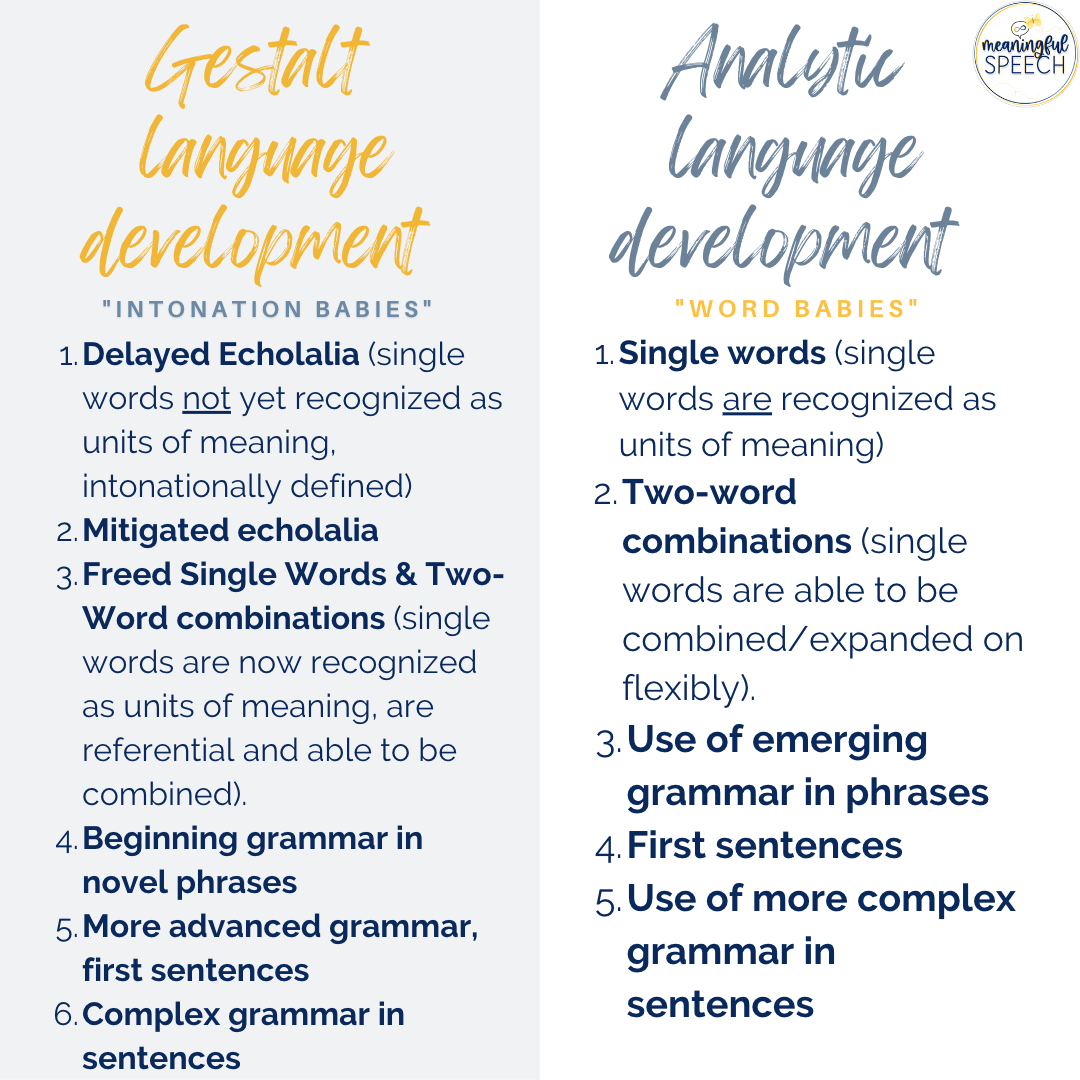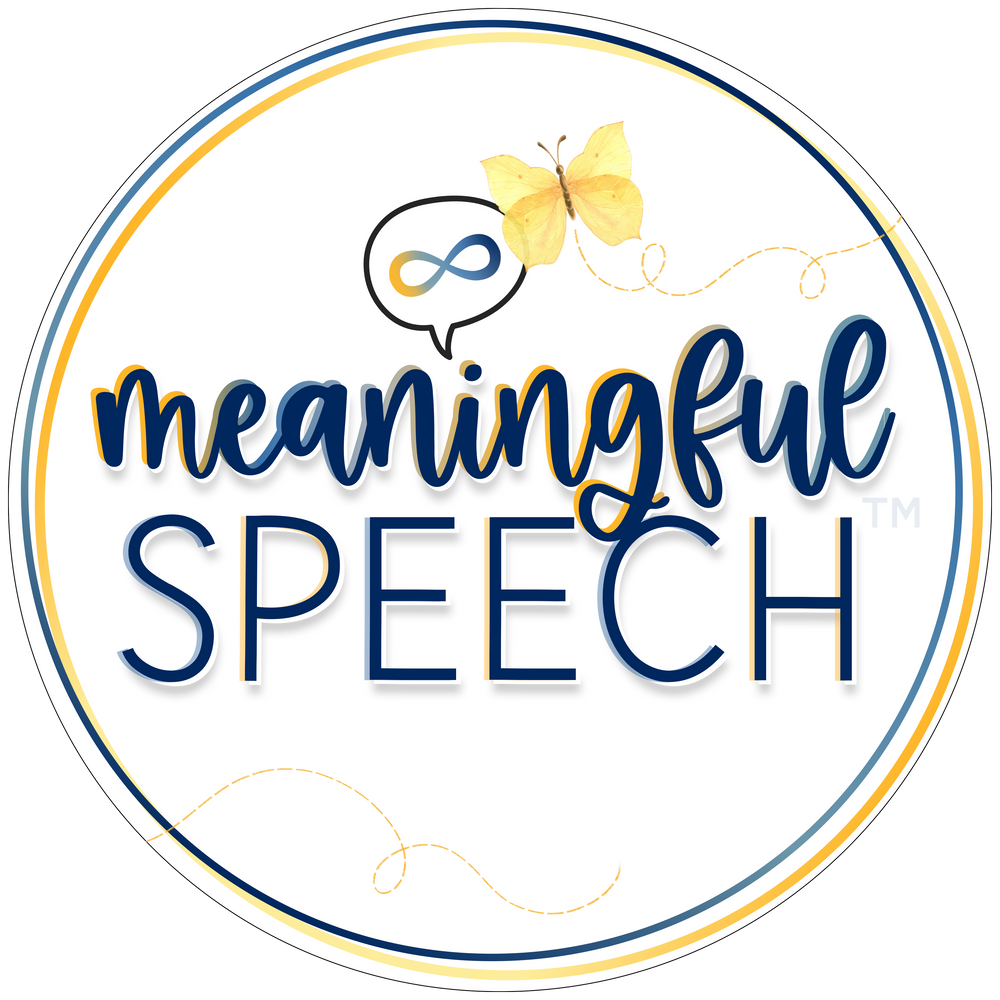Single Words: Let’s clear up the misconceptions
Jul 05, 2023
Single words cause a lot of confusion when it comes to identifying a child’s language development style. This is because analytic language processors and gestalt language processors often both use single words in Stage 1. Analytic language processors' basic units of language are single words. Their first stage of language development is using single words as units of meaning to communicate. Whereas gestalt language processors basic units of language are intonationally defined strings of language that are tied to a meaningful experience. Their first stage of language development is delayed echolalia, or the use of gestalts to communicate. They pick up language that is often intonationally defined and holds a much larger meaning and typically a whole experience with it. Many people think that gestalts only consist of long scripts from media or communication partners but gestalts can be as short as a single word.
Some children acquire a repertoire of many single word gestalts
We often hear from parents and professionals that they initially thought a child was an analytic language processor because they used single words to communicate early on. Therefore, they began using analytic language strategies (expanding utterances, labeling, vocabulary building, etc.) to support their language development until they realized the child wasn’t responding to these strategies. They eventually realized or were told that the child is actually a gestalt language processor. People are often confused by this and ask, “how could my child be a gestalt language processor if they started out by using single words?” This is because those single words are likely single word gestalts.
How can we know if a single word is a gestalt or not?

Analytic language processors will pick up single words and are able to use them referentially and flexibly from the start. They are able to point to the objects they’re referring to and as they move into stage two of their language development and beyond, they’re able to combine these flexible single words into two-word combinations and eventually phrases and sentences with grammar. Whereas with gestalt language processors, the single words they acquire in the early stages are not flexible and often are not referential. We know the difference through collecting language samples and knowing the child’s language history. Some things to consider to help determine the difference include:
- Does the child have a history of Applied Behavioral Analysis (ABA) or analytic language treatment? These therapies and strategies often focus on increasing vocabulary and labeling. These strategies are not supportive for gestalt language processors in the early stages and often leave them with a repertoire of single word gestalts. For older gestalt language processors, they may acquire hundreds of single word gestalts from this. However, these single words are “stuck”. They cannot build upon or expand on them. Just like a multi-word gestalt, a single-word gestalt is learned as a unit and holds a much larger meaning to the child. They do not recognize them as single units of meaning that can be combined/expanded on when they are in the early stages of gestalt language development.
- Is the child using the word across contexts? Are they able to combine the single word with other single words? If the child is able to combine the word with other single words flexibly and/or is able to combine the single word with other single words or create self-generated phrases or sentences, it’s not a single word gestalt. On the other hand, if the child is consistently using the single word in the same context and is unable to expand on the single word by combining it with other single words or creating phrases and sentences, it’s likely a single word gestalt.
- Does the child point the object referentially? If the child is able to point to the object they’re referring to, it’s likely that the word is being recognized as a unit of meaning and is referential. Gestalt language processors often do not point until they’re in stage 3. This is because up until that point they’re not using language referentially. Note: Not all “pointing” is a physical point with an isolated finger. Some children will not be able to physically point.
- Listen to the intonation. Does the child say the single word the same way, with the same intonation every time they use it? Gestalt language processors are intonation babies. They pick up language in the earlier stages because of the intonation. They repeat this language the same way it was originally heard using the intonation of the original speaker.
- Some single word gestalts are not "taught" but naturally acquired from conversation. They are often exclamations like, "wow", "sorry", or "thanks", as well as, "yes", "no" and "stop". If the child is a gestalt language processor, they don’t recognize these single word exclamations as a single unit of meaning. Like we mentioned above, they might use these single words in the same context every time or use the same intonation (from the original speaker) every time they use these single word exclamations.
What to do if you suspect they’re single word gestalts
- Switch your approach. If you’re currently using analytic language strategies with the child, switch your approach. If you’re still not sure whether your child or client is a gestalt language processor, consider working with or consulting with a speech-language pathologist who is trained or knowledgable about gestalt language development and Natural Language Acquisition. Different language development requires different language support. We want to use the Natural Language Acquisition (NLA) framework to support gestalt language processors. This includes:
- Using naturalistic language modeling in everyday routines using declarative language (narrating, commenting)
- Eliminating focus on single word modeling, asking questions, expanding utterances and focusing on grammar in the early stages (Stages 1 & 2).
- In the first stage of gestalt language development, modeling more gestalts that can be easily mixed and matched when the child is ready for stage 2.
- Using child-led therapy, focusing on connection and trust over compliance-based methods.
- Leave single word gestalts ALONE. Don't try to expand upon them. Gestalt language processors cannot expand or build upon their single word gestalts. Just acknowledge them and let them be.
- Child: “Car”
- Adult: “Let’s go in the car!”
- Example:
We do not want to try to expand upon the single word gestalt like the adult does in this example. The child does not process “car” as a true single word and therefore is unable to expand on it. Instead an interaction might look like this:
- Acknowledge all gestalts, long or short by smiling, head nodding, saying "yeah" or "okay" or repeating the gestalt.
- Model NEW 2-3+ word gestalts for the child. A gestalt language processor in stage 1 needs more gestalts. Just like an analytic language processor needs more words in the first stage of their language development, a gestalt language processor needs more gestalts in their first stage!
- Child: “Car”
- Adult models: *nods to acknowledge “car” and models “Let’s go!”
- Example:
*the adult knows the child uses this single word gestalt everytime they want to go somewhere so they model a completely novel gestalt instead of trying to expand or build upon “car”*
Don't worry if you are working with a child that has a lot of single word gestalts that were taught or inadvertently picked up. When they get to stage 3 and "free" all the words from their longer gestalts plus begin to process words as units a lot will fall into place for them. Keep your focus on modeling more gestalts in stage 1. Keep things playful, vary your intonation and bring in the excitement and drama. That's what makes new gestalts "stick" for GLPs!
Want to learn more in-depth information about how to support gestalt language processors?
- There are many free podcasts, webinars and articles to get you started. A comprehensive list of resources can also be found on our website and Communication Development Center's website.
- Consider taking the Meaningful Speech course to learn more about how your child or client processes language, how you can help support them from echolalia to self-generated (original flexible) language, child-led therapy, and neurodiversity-affirming practices.
- Consider taking our AAC + Gestalt Language Processing course . It will teach you how to identify, evaluate and support gestalt language processors who use AAC or who you think might benefit from AAC.
- Look for a speech-language pathologist (SLP) who "gets it" and can help you in supporting your child's language development. Check out our registry. for SLPs who understand gestalt language processing and child-led therapy.
- Are you a school-based or private practice clinician looking for intake forms for new clients/students or creative visual reminder posters for your space? Check out the Meaningful Speech Marketplace.
